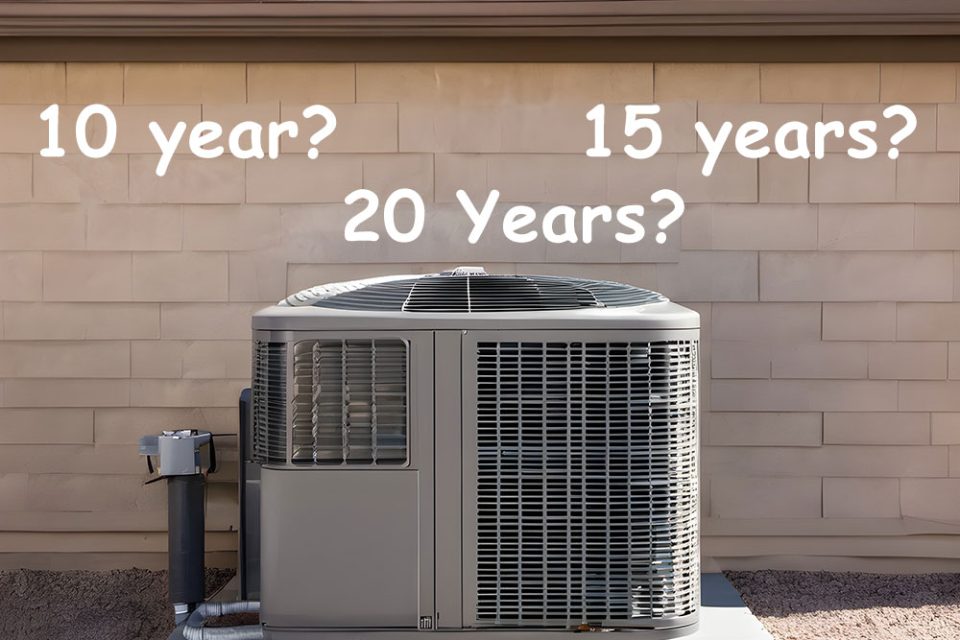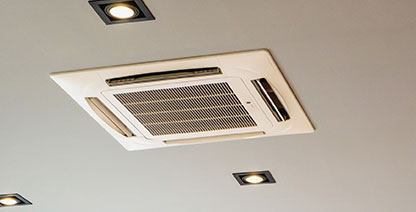What is the lifespan of my HVAC system?

The simple answer is that for most homeowners in Las Vegas, NV, an AC system typically lasts about 12 years. However, there are instances where a well-maintained system can continue functioning up to 25 years.
Navigating the Longevity Labyrinth of Your HVAC System
In the nuanced world of home maintenance, the story of an HVAC system unfolds quietly yet significantly, much like a character from a gripping novel that commands attention not through grandeur but through steadfast presence. It’s an unassuming yet indispensable part of our daily lives, often unnoticed until the comfort it provides is compromised.
So, we find ourselves asking a question that’s as practical as it is profound: How can I guide my HVAC system to last beyond the impressive milestone of 20 years? The answer lies not in grand gestures, but in the details – the small, consistent acts of care and foresight.
Consider your HVAC system as a journey through time, requiring not just mechanical efficiency but a touch of wisdom. To travel this path, we look towards a blend of regular maintenance – the art of keeping air filters clean, the finesse of using programmable thermostats wisely, and the science of maintaining unobstructed airflow. These are not mere tasks; they are the stepping stones to longevity.
Embark on this journey with us as we review the best tips to maintaining and significantly extending the life of your HVAC system. Our aim is to help you sidestep the high costs associated with AC system replacements or frequent, expensive AC repairs. Let’s turn the mundane into the extraordinary, ensuring that your system doesn’t just survive, but thrives, for over two decades.
The Art of Comprehensive HVAC Maintenance
Embarking on an annual 28-point inspection and tune-up service for an HVAC system is like navigating through a complex labyrinth, ensuring every turn leads to optimal performance and extended system life. Each point is essential to the overall health and efficiency of the HVAC system.
The 28-Point Inspection: This thorough inspection begins with a focus on all filters, including media or whole-home air filters, to improve indoor air quality. Maintaining clean and efficient air flow is a key aspect of system health.
- Inspection of all filters, including media or whole-home air filters, to ensure indoor air quality.
- Examination of the blower wheel.
- Testing and inspection of the condensate drain line.
- Inspection of the outdoor (condenser) coil, if accessible.
- Visual checks for refrigerant leaks.
- Cleaning and operational testing of the thermostat.
- Checking the metering device, if accessible.
- Assessment of return air temperature.
- Checking supply air temperature.
- Measurement of wet tub temperature, if applicable.
- Evaluation of temperature drops.
- Inspection of the disconnect box, wire sizes, and tightening of any loose connections.
- Assessment of the operation of service valves.
- Testing and measurement of capacitor voltage and start component.
- Amperage testing of the compressor.
- Examination of contactor and relays.
- Checking compressor and fan motor current.
- Measurement of the suction line temperature.
- Assessment of suction pressure.
- Measurement of superheat/subcool.
- Evaluation of the air entering the outdoor coil.
- Measurement of discharge temperature and pressure.
- Checking the refrigerant charge.
- Evaluation of the condition and overall efficiency of the equipment.
- Visual inspection of insulation for proper levels and conditioning.
- Visual inspection of air ducts for correct sizing and leakage.
- Water washing of the condensing coil.
- These comprehensive checks ensure that every component of the HVAC system is functioning efficiently and effectively.
This detailed 28-point inspection and tune-up service ensures that every facet of the HVAC system is evaluated and optimized, setting the stage for reliable performance and an extended lifespan.
The Mastery of Air Filters
Air filters in your HVAC system play a critical role, similar to how lungs function in the human body. They are responsible for maintaining the system’s health and efficiency by filtering out dust, pollen, and other airborne particles. This prevents these particles from circulating in your living spaces and clogging the system.
The process of changing air filters is more than just a routine maintenance task; it’s a crucial step that significantly impacts the performance of your HVAC system. Regularly replacing air filters, typically every 30 to 90 days or when visible dirt and clogging are noticed, is key. A clogged filter forces the system to work harder to circulate air, leading to increased energy use and potential wear and tear.
By consistently maintaining and replacing air filters, you ensure that your HVAC system operates at its best. This not only contributes to a healthier living environment by improving air quality but also extends the lifespan of the system. Timely filter replacement is a simple yet effective way to enhance the efficiency of your HVAC system and maintain optimal indoor air quality.
The Wisdom of Programmable Thermostats
In the modern era of technology and smart living, programmable thermostats stand out as key tools in enhancing the efficiency and lifespan of your HVAC system. This innovative approach to temperature control goes beyond the capabilities of traditional thermostats, offering significant benefits in terms of energy savings and system wear and tear.
- Understanding Programmable Thermostats: Programmable thermostats differ from traditional ones by allowing you to set specific temperature schedules based on your daily routine. This means that your HVAC system doesn’t have to work continuously, thereby reducing unnecessary strain.
- Intelligent Temperature Control: With a programmable thermostat, you can set lower temperatures during winter nights or adjust the temperature when the house is empty. This simple change can lead to notable energy savings, as the system isn’t working harder than necessary.
- Learning and Automation in Smart Thermostats: Many modern programmable thermostats are equipped with smart features. They can learn your preferences over time and adjust the settings automatically for optimal comfort and efficiency. These smart devices can also provide valuable insights into your energy usage, enabling you to make more informed decisions about your HVAC system’s operation.
- The Role of Programmable Thermostats in HVAC Longevity: By utilizing programmable thermostats effectively, they become more than just a convenient accessory; they play a major role in prolonging the life of your HVAC system. They help maintain a balance between comfort and energy efficiency, ensuring that your system isn’t subjected to unnecessary stress.
Integrating a programmable thermostat into your HVAC system is a smart move towards ensuring its longevity and efficiency. It’s a small change that can make a significant difference in how your system operates and conserves energy.
Ensuring Proper Airflow

Ensuring proper airflow is a vital yet often overlooked element in HVAC maintenance. Homeowners can take proactive steps to ensure their system operates efficiently and effectively, thereby extending its lifespan. Here are some DIY steps for maintaining proper airflow:
- Clearance Around the Condenser: It’s important to keep the area around the outdoor condenser unit clear of trees, shrubs, or any obstructions. Maintaining a clearance of about three feet around the condenser is a good rule of thumb. This clearance helps in the effective release of heat and prevents the HVAC system from overworking.
- Vents Management: The positioning of vents can have a significant impact on heating and cooling efficiency. Generally, it’s beneficial to direct the vents towards windows or areas where heat may enter. This strategy helps to counteract the effects of external heat sources and maintain a consistent temperature.
- Cleaning Vents, Registers, and Return Air Grilles: Keeping vents, registers, and filtered return air grilles clean is important. Dust and debris can build up over time, impeding airflow. Regularly removing any accumulation of dust with a vacuum can help maintain unobstructed air circulation.
By following these DIY steps, homeowners can improve the airflow in their HVAC system, ensuring it runs more efficiently and effectively. Regular attention to these aspects of HVAC care is a proactive measure towards prolonging the system’s life and enhancing its performance.
Key Takeaways
Realize the impact of regular maintenance, smart thermostat use, proper airflow and professional check-ups on the lifespan and performance of HVAC systems. The goal is to encourage homeowners to adopt these practices, ensuring their HVAC system not only survives but thrives for over 20 years.

